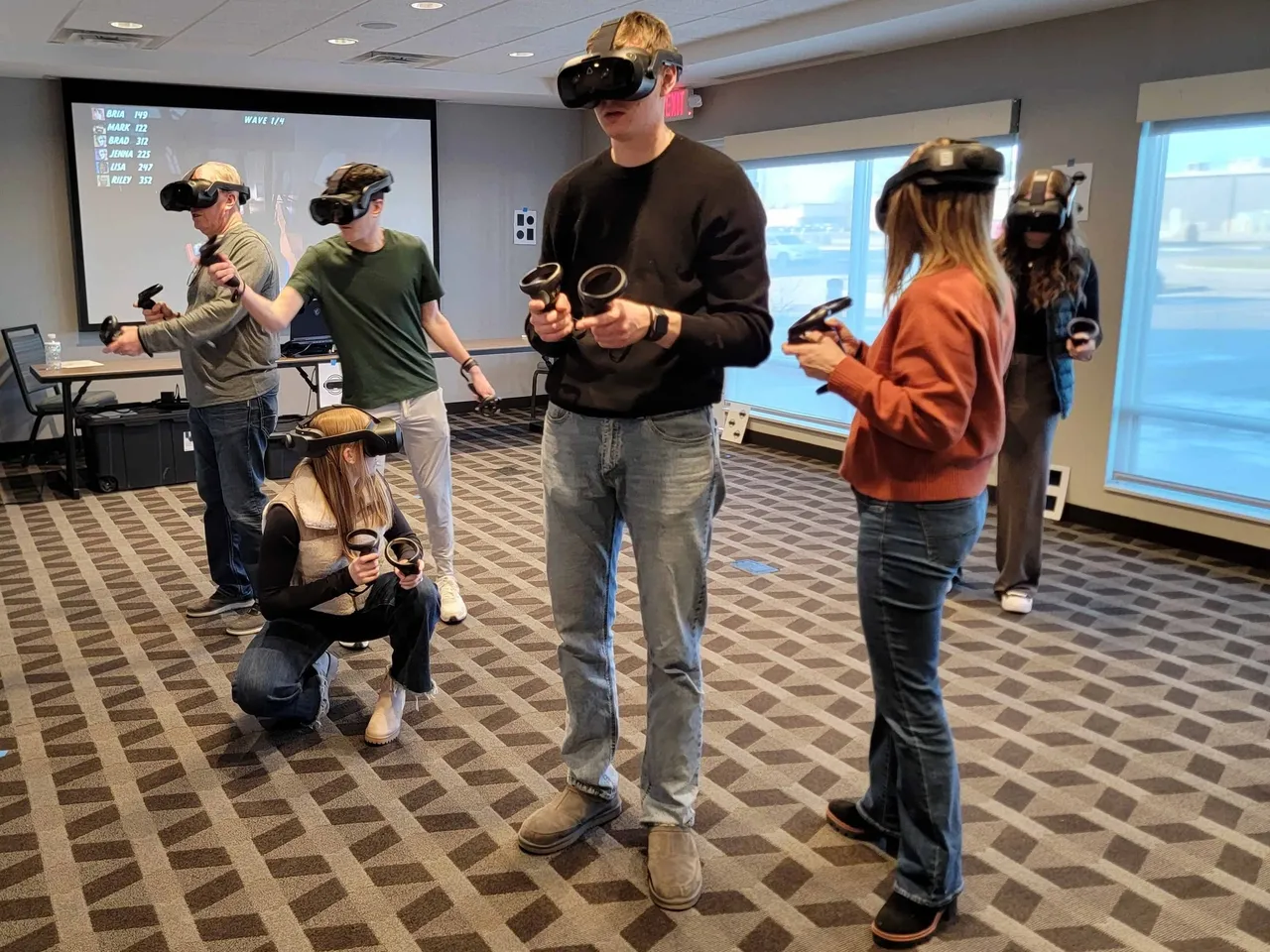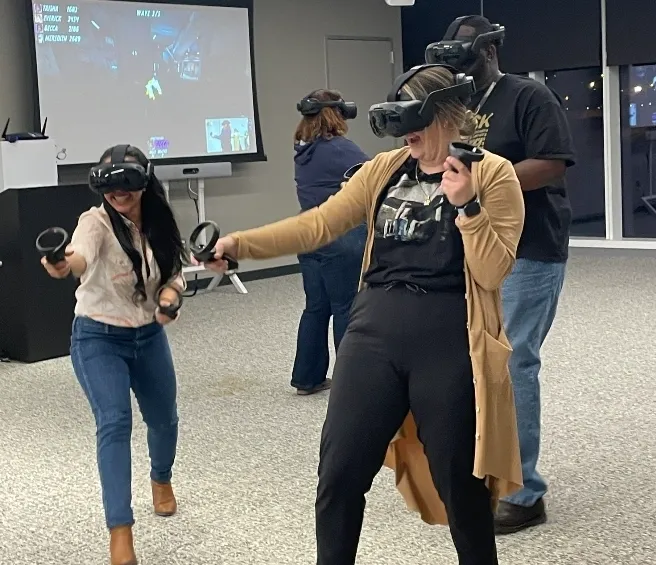You’re here because you want to learn some effective team-building techniques for your small team. This means you’re looking for more than just a fun outing, like a day of bowling. Instead, you want intentional team-building activities that are exciting and purposeful—something that strengthens collaboration, improves communication, and fosters trust among team members. You also have a smaller team, so renting out an entire rock climbing gym or paintball facility might not be in the budget. Well, you’re in the right place.
Here’s our list of favorite team-building activities for small groups. We’ve separated the list into two categories:
Practical Team Building Activities for Small Teams
Entertaining Team Building Activities for Small Teams
At True Echo VR, we believe in three pillars of team building: Fun, Unfamiliar Environments, and Collaboration. Not all team-building activities will include all three, but all activities should at least include one of these. That being said, let’s dive into the practical team building activities first.
Practical Team Building Activities for Small Teams – Add to Your Day-to-Day
1. Goal Mapping Workshop
Why it works: Goal mapping encourages role clarification and goal alignment, both of which are key to effective teamwork. A meta-analysis by the American Psychological Association found that team-building activities focusing on role clarification and goal setting significantly improve team performance and processes. When team members understand their roles and objectives, they are more likely to collaborate effectively and achieve better outcomes.
How to do it:
- Gather your team in a quiet space with tools like sticky notes or a digital whiteboard.
- Start by identifying a shared goal. For example, “Increase customer satisfaction by 20% in three months.”
- Have each team member contribute ideas for achieving that goal.
- Assign roles based on individual strengths and expertise, and explain how everyone’s job responsibilities help achieve the goal
Example: A marketing team might set a goal to launch a new campaign. The team works together to identify tasks like content creation, ad placement, and performance tracking, assigning each task to the best-suited person.
2. Knowledge Sharing Workshop (Jigsaw Method)
Why it works: This activity is rooted in cooperative learning. Research shows that cooperative learning strategies, like the Jigsaw method, enhance engagement and learning outcomes by ensuring everyone contributes actively while also gaining insights from others. It also promotes critical thinking and collaboration.
How to do it:
- Assign each team member a specific topic or piece of information related to a larger goal.
- Give them time to research or prepare their part.
- Have each person present their piece to the group, creating a complete understanding of the topic.
Application: Say your business is thinking of expanding into new territory, or needs to learn more about your competitors. Select a day about a week into the future, ask different teams to research different aspects of the goal, and have them present what they find on meeting day.
3. Reflection and Feedback Session
Why it works: Reflection helps teams grow by identifying what works well and what can be improved. Structured feedback sessions improve team learning and effectiveness by fostering open communication and shared understanding.
How to do it:
- After any team-building activity, schedule a 15-minute debrief.
- Ask open-ended questions like:
- What did we do well?
- What challenges did we face?
- How can we apply what we learned to our work?
Example: After an escape room challenge, discuss the roles each person naturally assumed and how those roles align with their day-to-day responsibilities.
4. Myers-Briggs Personality Test
Why it works: Understanding team members’ personality types can improve trust, communication, and collaboration. The Myers-Briggs Type Indicator (MBTI) provides insights into individual preferences, helping team members appreciate each other’s strengths and differences. Assessments, when combined with open communication, significantly enhance team dynamics and trust. For small teams, typically everyone on the team knows everyone else. It’s easy to become complacent, and stop striving to build team cohesion. These activities encourage communication and problem-solving, which are critical for a small team’s success.
How to do it:
- Have team members take the Myers-Briggs test, which is widely available online or through certified facilitators.
- Host a team discussion where each person shares their results, focusing on how their personality type influences their work style and communication preferences.
- Encourage team members to open up about their challenges, hobbies, or goals to create a safe space for vulnerability and trust.
Pro Tip: Use this information to tailor team-building activities or assign roles based on personality strengths. For example, an “Introverted” team member might prefer analytical tasks, while an “Extroverted” member thrives in brainstorming sessions.
The key takeaway here is that team building is not a one time event where you do something fun on a Friday. Effective team building is ongoing, done in and out of the office, in day-to-day work and also as fun outings.
Now lets get to the fun stuff!

Entertaining Team Building Activities for Small Teams
We’re biased, so we’ll say True Echo VR is the most entertaining…. but we’ll save that for last. Here are some other great entertaining team building activities.
1. Escape Room Challenges

Why it works: Escape rooms are excellent for promoting teamwork under pressure. They require problem-solving, communication, and quick thinking, which are all vital skills for any small team. According to a systematic review published in PLOS ONE, teamwork training activities like escape rooms improve both team behaviors and overall performance, particularly in high-stakes scenarios.
How to do it:
- Book an escape room local to you, click here for a couple near Milwaukee Wisconsin
- Split the team into small groups and challenge them to “escape” by solving puzzles within a set time limit.
Pro Tip: After the activity, hold a debrief to discuss what strategies worked well and how the team can apply them to workplace scenarios. Go over communication styles: did anyone take the lead? Did anyone get silent when the team got stuck?
2. Blindfolded Navigation
.jpg/:/cr=t:0%25,l:0%25,w:100%25,h:100%25/rs=w:1280)
Why it works: This activity builds trust and communication by requiring one person to rely entirely on another for guidance. Trust-building exercises like this have been shown to strengthen group cohesiveness, which is directly linked to improved team performance.
How to do it:
- Set up a simple obstacle course in a large room or outdoor space.
- Pair team members and blindfold one person in each pair.
- The other person gives verbal instructions to guide their partner through the course.
Pro Tip: Switch roles midway so both team members experience leading and following. Assign points and compete as a team to promote employee engagement. Or add this as a part of a larger team building day.
3. Improv Games

Why it works: Improv games are fantastic for breaking down barriers, encouraging adaptability, and fostering a shared sense of fun. A study published in the Journal of Business Communication found that humor and spontaneity in team-building activities reduce tension and improve team dynamics, especially in smaller groups.
How to do it:
- Try the “Yes, And…” game. One person starts a story, and each team member adds to it, beginning their sentence with “Yes, and….”
- Make the story about your business, your competitors, or your industry. Add silly phrases yourself so your group knows it’s okay to think outside the box!
- This activity ensures that everyone listens actively and builds on others’ ideas.
Pro Tip: Use this activity to energize the team before brainstorming sessions.
4. The Marshmallow Tower Challenge
.jpg/:/cr=t:0%25,l:0%25,w:100%25,h:100%25/rs=w:1280)
Why it works: This classic activity fosters creativity, collaboration, and iterative problem-solving. Cooperative learning techniques like this encourage active participation from all members, promoting accountability and teamwork.
How to do it:
- Provide teams with 20 pieces of spaghetti, one yard of tape, one yard of string, and one marshmallow.
- The goal is to build the tallest tower that can support the marshmallow on top.
- Teams have 20 minutes to complete the challenge.
Example: Use this as a warm-up exercise during team workshops to observe group dynamics and spark creative thinking.
Okay, we’ve shown you some of our favorite team building activities and philosophies, each of which can be used for small teams… now let us brag a bit.
True Echo VR’s Kitchen Simulator

Why it works: This activity combines the thrill of VR with teamwork in a high-pressure, fun environment. Participants must communicate effectively, delegate tasks, and adapt to fast-paced challenges to “cook” and serve meals in a virtual kitchen. It mirrors real-life teamwork scenarios, fostering collaboration and quick decision-making. It also includes the three pillars we believe are key for successful team building: Fun, Unfamiliar Environment, and Collaboration. This activity works well with groups of any size, but can be done with as few as four people, meaning it can be effective for your small team!
How to do it:
- Book a True Echo VR team building event by calling or emailing. (Currently servicing Southeast Wisconsin and surrounding areas).
- Split the group into small teams, with each person taking on a specific kitchen role (e.g., grill station, bun station, kitchen manager etc.).
- Teams must work together to prepare and serve as many virtual meals as possible within the time limit. Teams can compete against each other, or against their previous score.
Pro Tip: After the activity, discuss the importance of clear communication and how adapting to different roles contributes to team success.
More information on True Echo VR Experiences here: True Echo VR
Making Team Building Effective
While these activities are fun, the key to effective team building is intentionality. Choose activities that align with your team’s goals and address specific challenges they face. Whether it’s improving communication, fostering trust, or enhancing problem-solving skills, the right activity can make a big difference.
Take Action: Start by identifying your team’s needs. Do they need better communication? Stronger trust? A clearer understanding of their roles? Once you know the “why,” select an activity that targets that area.
By incorporating these purposeful and exciting activities, your small team will grow stronger, more cohesive, and ready to tackle any challenge.
We truly hope this article was helpful!
Other Team Building Activities:
25 Team Building Activities for Small Groups


